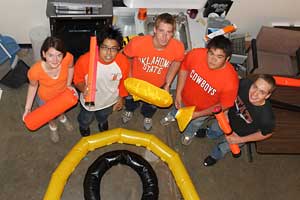NASA selects OSU as finalist for inflatable loft competition
Friday, September 17, 2010

The OSU team, called the “Space Cowboys”, was chosen, along with teams from the University
of Maryland and University of Wisconsin-Madison, based on initial proposals for concepts
that can be integrated with NASA’s current operational hard-shell prototype habitat.
“All three teams will go head-to-head at the Johnson Space Center in Houston next
summer to demonstrate an attachable, inflatable habitat that could serve as the next
generation lunar module,” said Dr. Jamey Jacob, associate professor of mechanical
and aerospace engineering, who will serve as adviser to the OSU team.
“Of course, OSU is pleased and excited to be selected for this opportunity, despite
the fact that both Maryland and Wisconsin have very large aerospace engineering programs.
Our students are among the best and brightest in the country, so I have no doubt that
we will prevail—but it won’t be a cake walk,” said Jacob.
The schools will compete by successfully demonstrating their own versions of the next
eXploration Habitat or X-Hab in June 2011 in Houston, where the winning team will
be awarded additional funds to integrate their design with the NASA habitat during
field testing in August and September.
“This competition gives these students the opportunity of a lifetime,” said NASA Chief
Technologist Bobby Braun at NASA Headquarters in Washington. “They'll design and build
new hardware. If their team wins, they'll get the chance to integrate their designs
into a NASA hard shell habitat and see it field tested next summer.”
The National Space Grant Foundation will award the three teams $48,000 each to cover
the costs of their design development and participation in the head-to-head competition.
An additional $10,000 will be awarded to the team that wins the competition to offset
their costs of participating in the integrated field testing.
However, based on his estimates, the $48,000 will not cover the cost of constructing
the prototype as well as travel to NASA, so Jacob is seeking corporate sponsorship
for the OSU team.
